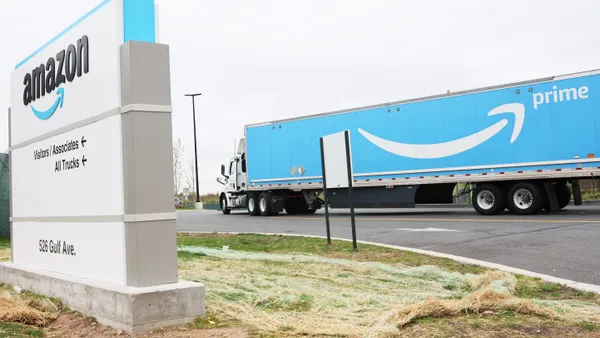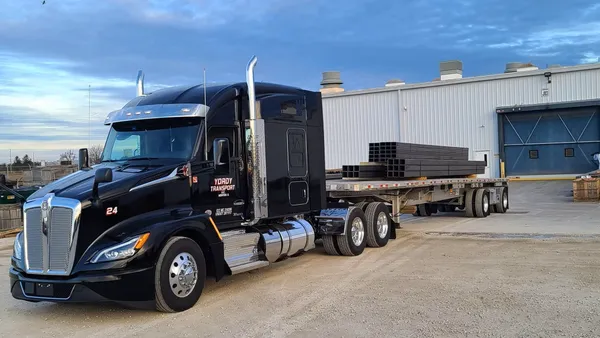Dive Brief:
- Two-thirds of respondents in a survey of 519 supply chain professionals by Transfix said they do not have full confidence in their carriers. The pandemic-driven uptick in e-commerce is coalescing with peak volumes, and shippers are unable to turn to their typical logistics providers.
- "That reliability gap poses real risk and comes with steep costs," according to the report, released Thursday. Of respondents, 86% said high freight-rejection rates increase transportation expenses. And nearly three-fourths said a lack of proactive freight-exception management hikes related costs.
- One in three supply chain professionals polled said the lack of freight-exception management poses a risk to success during the holiday season, while nearly half (43%) said it poses a risk to long-term success.
Dive Insight:
Trucks are full, and volatility has been high for months. As carriers attempt to juggle the spike in volume with customer service and meeting preexisting commitments, many are telling shippers to look elsewhere.
"We've already heard of customers not being able to get capacity with certain carriers, or having very strict limits at specific locations," Convey's chief growth officer, Kirsten Newbold-Knipp, said during a webinar Tuesday.
UPS, FedEx, DHL and other major carriers are not accepting new customers through the end of the year, according to Convey.
"We work with our customers to help them rethink their operations via buy online pick up in-store, different timing for their promotions and different availability of their packages," UPS CEO Carol Tomé said on an earnings call Wednesday. UPS domestic volume was up nearly 14% YoY in Q3, and the company is now encouraging customers to bring holiday volume forward and even avoid shipping when possible.
Truckload carriers are also filling up fast. Shippers "are in need of help," said Knight-Swift Executive Vice President of Finance Brad Stewart on the company's most recent earnings call. And shippers are already taking the initiative to begin discussions about higher contract rates for 2021, he said.
But carriers and shippers ultimately want dependability, Transfix COO Ahmad El-Dardiry said in an email. Even though truckers pursue the best loads, consistency allows them to increase asset utilization and grow the business. And shippers need the efficiency that consistency provides.
On average, up to 30% of company time per week is spent finding backup carriers following tender rejections or missed pickups, according to the Transfix report. And 87% of respondents said this issue "is one of the biggest areas of wasted time across the supply chain."
Carrier diversification can help avoid this inefficiency. Sophisticated shippers used to be about 60% more diversified than others in Convey's customer base, Newbold-Knipp said. Now, that percentage is upwards of 80%. Experts were stressing to shippers months ago that looking to a range of carriers would be a key heading into peak.
"Understand the impact to your organization. Understand what your leverage points are. What options do you have? Is DHL an option? Are regional carriers an option?" David Sullivan, vice president of professional services at Shipware, said during a webinar in June. "I think a lot of shippers are going to learn a hard lesson during this pandemic: They need to diversify from a carrier perspective."
During that webinar, Sullivan suggested shippers bring on a weekend shift and give a carrier another pickup window to find capacity. Shifting some overflow volume to two-day or three-day shipping might also be a temporary fix.
But those moves require flexibility and extra costs. Though the industry is well into peak season, it's still worth trying to find alternate carriers.
"If you've been waiting to have some of those conversations with, you know, those regional parcel carriers, now is your best shot," Convey's co-founder and vice president of customer success, Dan Bebout, said during the webinar Tuesday. Customers that diversified their networks over the years are currently "far less reliant" on FedEx, UPS and DHL right now, he said.
Newbold-Knipp shared other tips for shippers on how to get around the capacity crunch:
- Ship less by offering other options, such as curbside pickup or lockers.
- Shift volume out of the peak-surcharge period by incentivizing customers to opt for after-Christmas or Sunday deliveries, for example.
- Shift volume in real-time using data through collaboration with the carrier.
- Understand where the leverage lies. "Know your volume. Know where your density is actually really valuable to a carrier," Newbold-Knipp said. Hand in hand with that is knowing where density is lacking, she continued, so shippers can think about delaying or bundling shipments, or moving volumes from one distribution center to another to create volume that is attractive to carriers.
Closing the reliability gap between shippers and carriers might come down to reinventing the model to break down the silos, according to El-Dardiry. Carrier and shipper data has historically stayed separate, while some parties are hesitant to hand it over to others.
"While this promise requires partnership based on commitment and predictable volume, innovative trucking technology fundamentally enables this much needed pivot," El-Dardiry said. If the carrier and the shipper have access to real-time information on pricing and location, he said, that transparency helps build trust.













